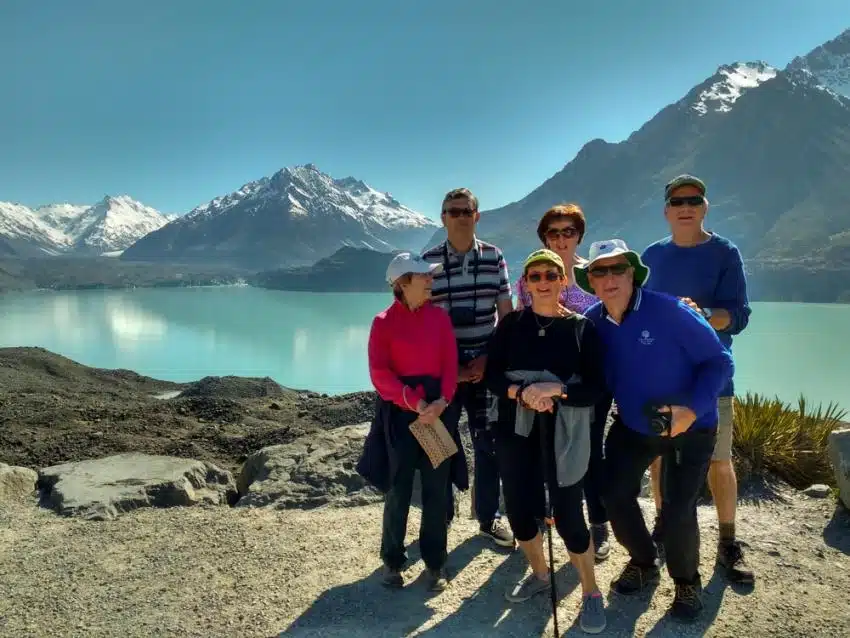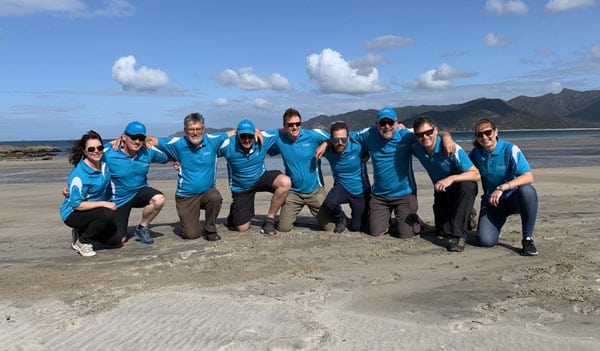Nearly one third of all glacier ice in New Zealand lies within the Tasman Glacier, a huge sheet of ice stretching across the flanks of Mt. Tasman and Aoraki/Mt.Cook.
All about the Tasman Glacier
This enormous natural phenomenon terminates into a glacial lake, which is expanding every day. Gargantuan chunks of ice break off from the glacier and float in the cold, blue waters of the lake. The bright azure waters contrast the surrounding snow-capped mountains, creating a landscape that is breathtaking.
This glacier has been carving the landscape of the Southern Alps for over two million years, crafting deep crevasses from the surrounding greywacke rock.
Witnessing the sheer scale and power of this natural shelf of ice is one of the highlights of traveling to the South Island of New Zealand. Read on for our guide to how to get to Tasman Glacier and what to do when you are there.
Fascinating facts about Tasman Glacier
- Tasman Glacier is 27 km long (16.7 miles) – making it the longest in New Zealand.
- The nearby Blue Lakes is the habitat of the smallest bird in New Zealand – the rifleman.
- The Tasman Glacier is the source of the popular and beautiful Lake Pukaki, which was created by the receding ice carving the rock over thousands of years.
- The milky-blue hue of New Zealand’s rivers is due to the finely ground rock that pigments the water. The fine sediment absorbs all of the colours of the spectrum except blue.
- The glacier was formed over 18,000 years ago, during the last ice age.
- Unfortunately, the glacier is only growing at a rate of 80 m per year, which is not enough to combat the speed of its retreat.
Photo credit: Wikimedia
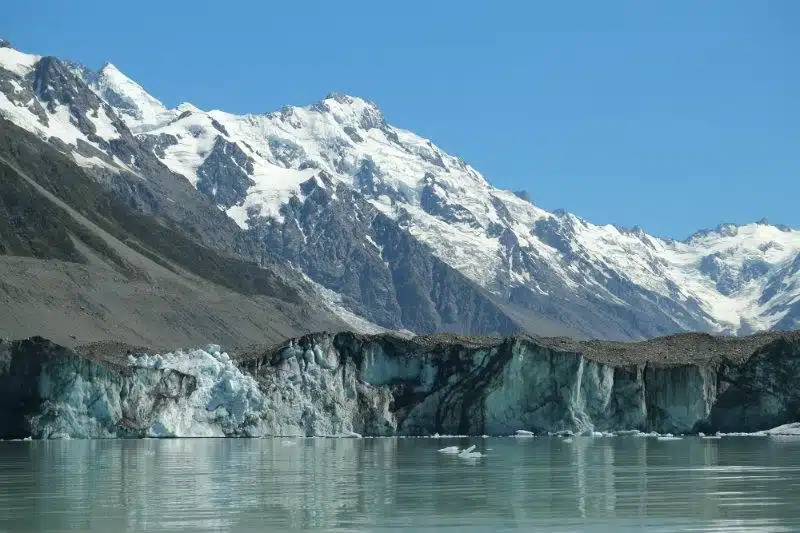
What makes Tasman Glacier unique?
The Tasman Glacier is the largest glacier in New Zealand – by far. The first 17km of the glacier is up in the mountains and remains frozen solid due to the cold, high altitude air. The snow falls high in the accumulation zone and is compacted over time and forced down the valley – scooping up rock and debris as it flows.
It takes approximately 300 years for the compacted snow to make its way through the glacier and reach the lake – and this movement is what has formed the Tasman Valley over time.
Tasman Glacier is also known for the bobbing icebergs that float in the nearby lake.
Location and how to get there
Nearest Airport: The nearest airport is Mount Cook airport. There are numerous flights that connect to this airport from other major cities in New Zealand including Queenstown, Christchurch and Dunedin.
Christchurch to Tasman Glacier: Tasman Glacier is a 3-4 hour drive from Christchurch., near the popular tourist spots of Omarama, Twizel and Lake Tekapo. From Twizel you can take an all-weather sealed road to Mount Cook Village.
Queenstown to Tasman Glacier: It’s possible to fly from Queenstown to Mount Cook airport with Glenorchy Air. Or, it is a 3-4 hour drive.
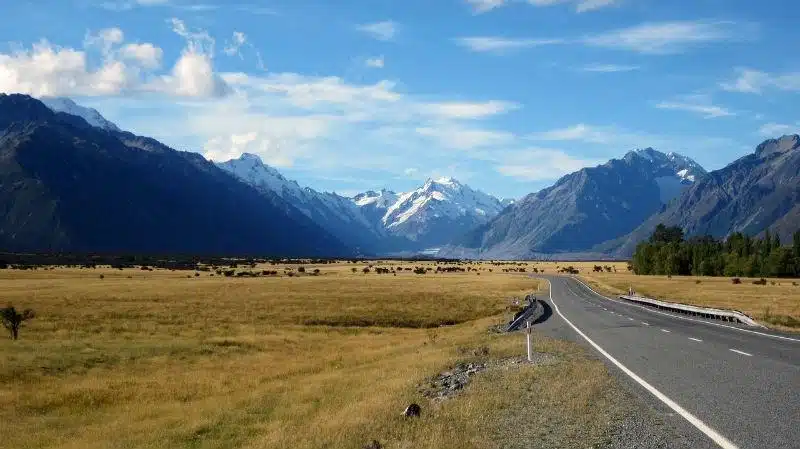
What to pack
- A t-shirt and a light fleece to wear overtop (layers are key because the temperatures can fluctuate quickly).
- A wooly jumper. (That’s Kiwi Speak for a warm sweater.)
- A waterproof windbreaker layer.
- Cotton pants or track pants (jeans are not recommended as they become heavy and cold if they get wet.)
- Sturdy hiking shoes or boots. (If you plan to hike on the glacier itself, your tour guide will supply the appropriate equipment.)
- Sunscreen and sunglasses. (The sun can reflect off the glacier and be quite strong!)
Weather and best time of year to visit
There’s no bad time to visit Tasman Glacier, as each part of the year offers something different.
Be prepared for rapidly changing weather when you are visiting Tasman Glacier – as this walk is in an alpine region. The best time to visit for the ideal weather is during the New Zealand summer from December to April. The months with the lowest chance of precipitation will be February, November and March.
However, if you visit Tasman Lake during the New Zealand winter, you’ll experience colder weather but fewer crowds and more peaceful surroundings. This is also a great time of year to see icebergs at their best and see the Ben Ohau Range covered in snow.
Want to see snow on the peak of Mount Cook? You’ll see some snow in any season, but the snow will be lower down the mountain in late autumn, winter and early spring.
However, keep in mind that since this region is at a high elevation – it can occasionally get snowed in during the winter. Also, you may not be able to do boat tours in the winter months. Many glacial lake cruise companies operate from the middle of September to late May, as the lake freezes over the winter.
Photo credit: Wikimedia
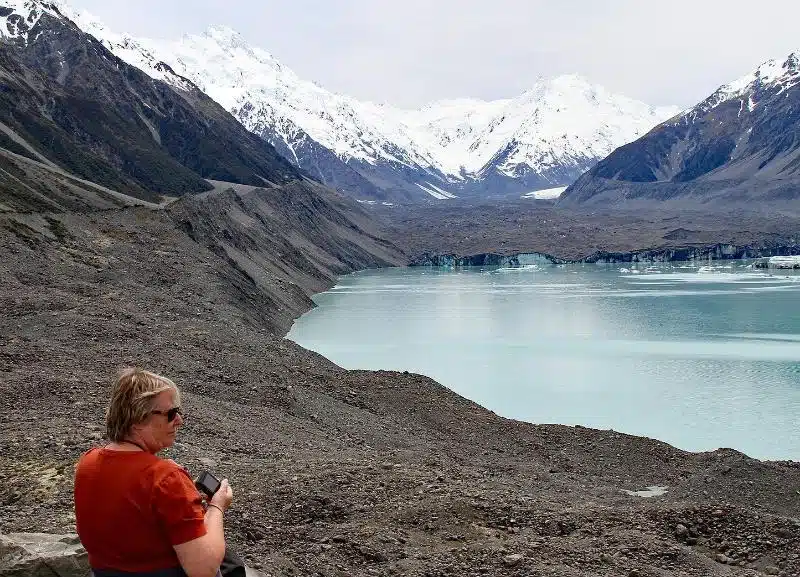
Safe travel tips when visiting Tasman Glacier
- Listen to the safety advice of your tour guide – they know the area and its risks.
- Check the weather forecast before your hike and don’t go out if a serious storm is predicted.
- Don’t hike alone. Find a partner, or join in with a guided tour.
- Wear sturdy hiking shoes that will give you the support you need on rocky mountain trails.
- Watch out for loose gravel on the paths that might cause you to slip and tread carefully.
- Beware cracks in the glacier, which are known as crevasses. They can be incredibly deep and very dangerous.
- When driving in this area, stay on the paved roads and don’t venture into unsealed four wheel drive tracks unless you are sure of your driving abilities and you are driving a suitable vehicle. (There are some roads in this area that are so dangerous that they are excluded from vehicle insurance policies.)
Accommodation options
When it comes to accommodation near Tasman Glacier, there are a few different options depending on your budget and your preferences.
For a budget option, there’s a number of hostels in the area – such as YHA New Zealand. It offers dorm beds at great prices, with clean, friendly communal lounge areas and a kitchen.
Another option is Glentanner Park, which offers everything from simple motel style units, dorms for backpackers, powered campervan spots and non-powered tent camping sites. (Plus, a pretty impressive view of Aoraki Mount Cook and Lake Pukaki.
If you are looking to treat yourself to an accommodation experience that is a little more luxurious, you can stay at the iconic Hermitage Hotel. The main hotel has 164 rooms with everything you need for a comfortable stay including tea and coffee facilities, ensuites, fridges and satellite TV.
Here’s a pic from the outside of the lovely Hermitage:
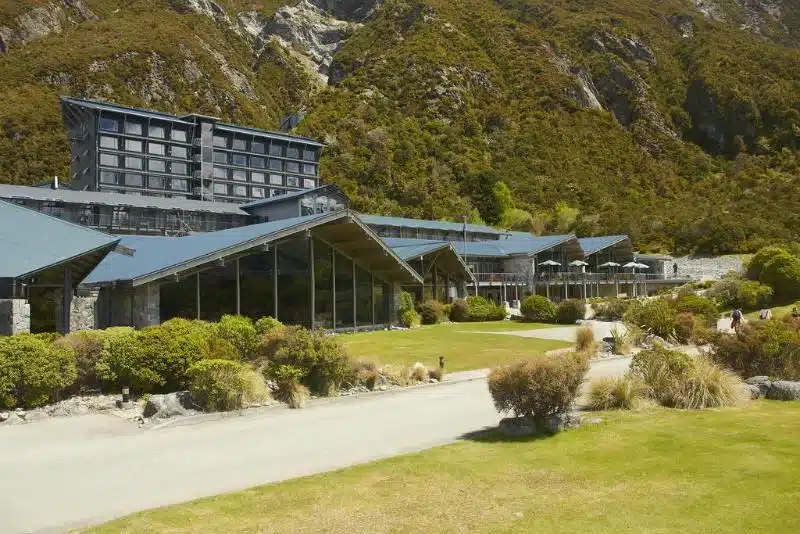
Things to do at Tasman Glacier
In addition to admiring the beautiful glacier, there’s so much more to do here. Here are some of the many great activities you can enjoy at Tasman Glacier. If you would like to book these activities as optional extras on our tours, just let us know!
Scenic helicopter rides
Seeing the Tasman Glacier from above is a New Zealand experience that should absolutely be on your bucket list. There are many scenic flights offered, taking off from Glentanner Park and hovering over the summits of Mount Tasman and Mount Cook.
Seeing the shimmering frozen expanse of the glacier from above will really give you a sense of the scale of this natural phenomena. Some helicopter tour packages will even offer you a heli-hike package, where you’ll have a chance to land on the glacier’s face and explore the caves and crevasses.
Photo credit: Ian Cochrane – Flickr
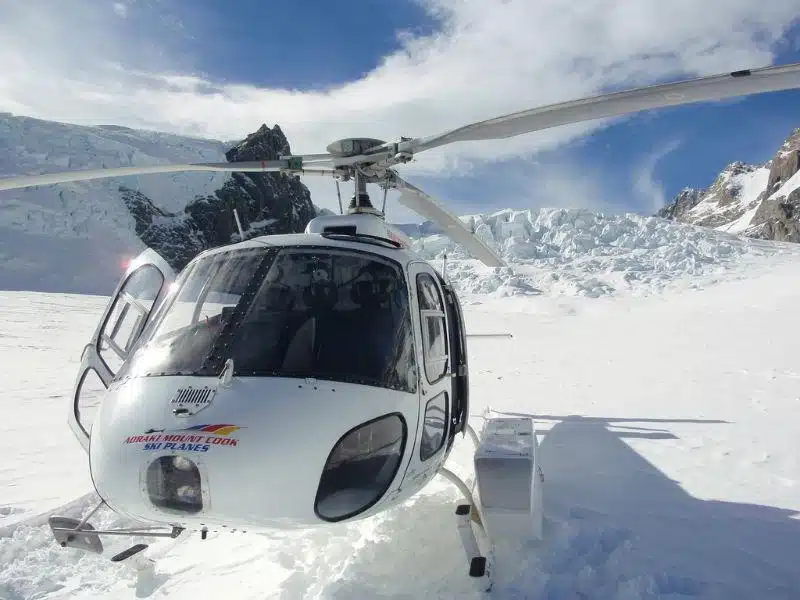
Kayaking
Glacier kayaking is one of the most exciting ways to experience this national park. You’ll glide silently through the icy waters, beneath the towering mountains and alongside enormous icebergs. On a kayak you’ll be able to get up close in the little nooks and crannies of the glacier lake and explore it in depth.
Many of the tours include the commentary of a knowledgeable local guide, who will give you insight into the natural history of the glacier.
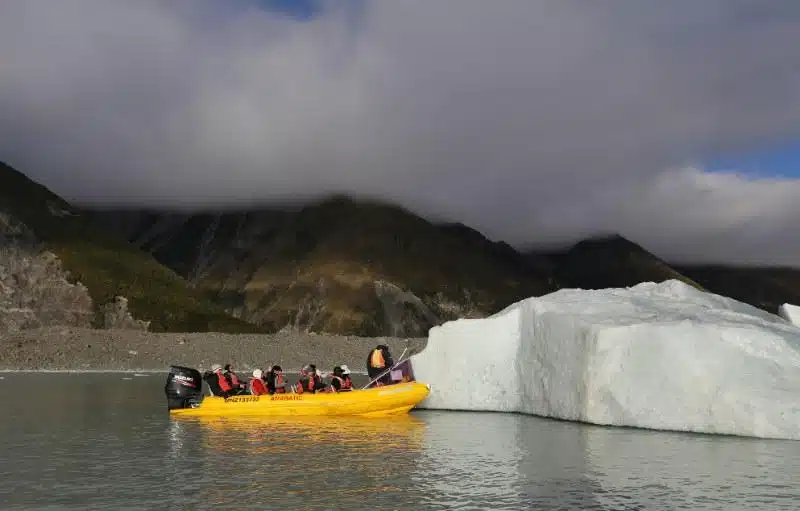
Skiing
For those who crave adrenaline, you can strap on a pair of skis and head to the top of the Tasman ice field via helicopter. You’ll be dropped off at the peak of the glacier in the morning and then you’ll be guided down the ice flow on the longest ski routes in the country. This is a thrill for skiing enthusiasts that is truly beyond the ordinary.
Short walks
There are many great short walks to enjoy around the area, if you are in the mood for an outdoor stroll. For example, the Blue Lakes and Tasman Glacier View hike is a 40-minute return walk, with a gentle incline on rock steps. You can enjoy great views of the lower Haupapa/Tasman Glacier, the lake, the mountains and icebergs.
Or, take the Tasman Glacier Lake hike – which will lead you through the glacier’s old terminal moraines and past a lake where you can see icebergs floating in the summer.
Photo of Bridge over Stocking Stream in winter – Credit: Pseudopanax@Wikimedia
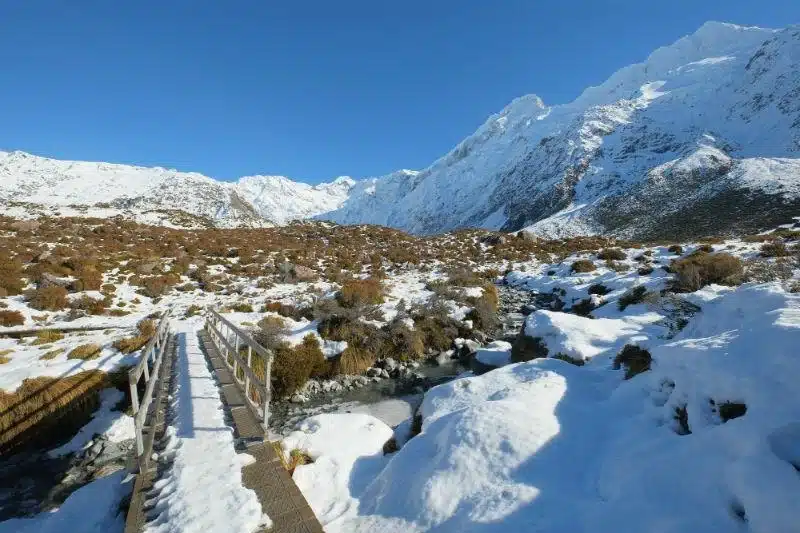
4 Wheel drive tours
Another one of the best ways to explore the Tasman Valley is to take a ride on the ridges and rocky moraines on a 4 wheel drive vehicle. The trips will take you deep into Mount Cook National Park, where you’ll see beds of alpine flowers, sheer crevasses of ice and towering mountains.
It’s a great way to explore that will allow you to see off-the-beaten track and get to places that you wouldn’t be able to reach any other way.
Astronomy Tours
Mount Cook National Park has a very dark night sky, which is ideal for stargazing. There is very little light pollution from nearby urban areas. In fact, it’s so dark that it’s one of the best places in the country for stargazing.
The best time of the year for stargazing is summer, as there will be less snow on the ground and therefore less light is reflected back into the dark sky.
Photo of the night sky outside Mueller Hut – Mount Sefton on the right. Photo credit: Aleks Dahlberg, Wikimedia
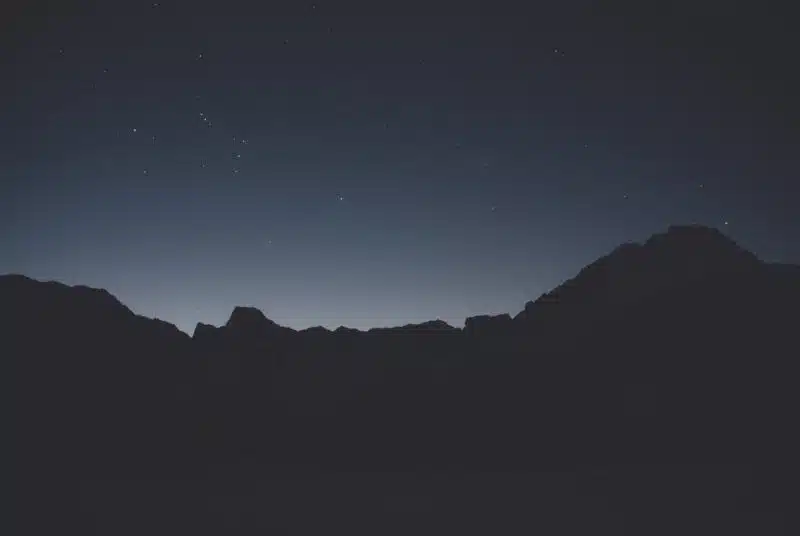
Glacial lake boat tours
If you are visiting Mount Cook National Park between September and May, you can take a ride on the special boat that offers tours along the surface of Tasman Lake. It’s an unforgettable experience that will allow you to see the icebergs close up.
On some trips you’ll even have a chance to taste the 500-year-old ice crystals and take a hike through the alpine lowlands.
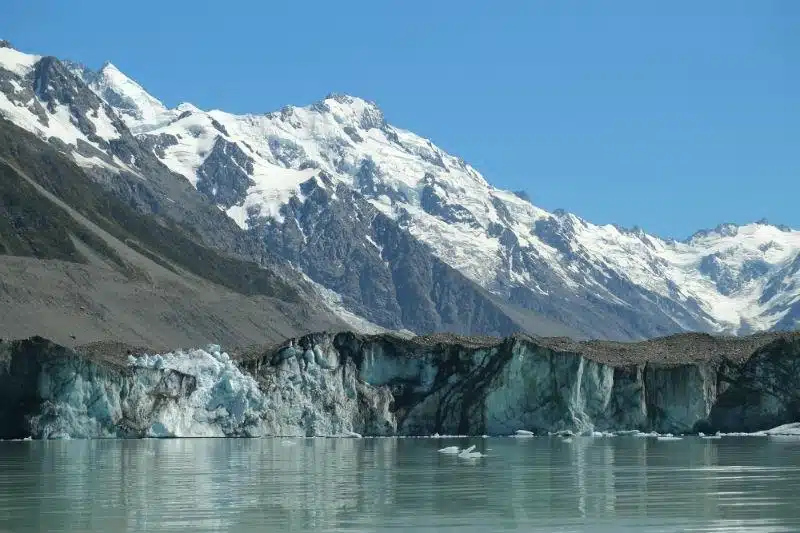
Guided tours vs. non-guided travel
Should you take a guided tour to Tasman Glacier, or go on your own? Consider the advantages of each:
Advantages of guided travel
- Your tour guide knows the local area and will be able to give you fascinating insights.
- Some of the parts of the glacier can ONLY be visited with a qualified guide.
- When you are on a group tour, you’ll get a chance to meet interesting people from all over the world.
- Accommodation, transport and meals will all be covered for you.
- Your tour guide will take care of booking all of the optional activities.
Advantages of Non-Guided Travel
- You will be able to design your schedule and travel at your own pace.
- You’ll be able to choose only the activities you really want to do.
- You can travel only with people you know, which means there is no risk of personality clashes.
One of the great things about our group tours is we keep our groups small. This means you’ll have more of a personal, intimate experience rather than being shuttled around with a huge crowd.
Tasman Glacier is featured on many of our multi-day tours.
If you have any more questions when planning your trip to Tasman Glacier, contact us. We are happy to help!


